Abstract
We have examined whether the human colon is able to adapt its capacity to receive fluid, specifically, whether the caecum and ascending colon ('right colon') exhibited any reservoir function. Healthy volunteers had the caecum intubated from above with a device that permitted intraluminal pressures to be recorded while fluids were instilled into the caecum. Perfusates contained 99mTc-DTPA (diethylenetriamine pentaacetic acid) and volumes of the right colon were determined by two plane scintigraphy using gamma cameras. Different individuals received caecal infusions of 154 mM NaC1 (saline), an emulsion of oleic acid (with bile acids and lecithin) or a 100 mM solution of mixed short chain fatty acids. Each person was pretreated by intravenous saline (placebo), morphine sulphate (100 micrograms/kg) or naloxone (5.5 mg as a bolus, followed by 10 micrograms/kg/min). Volumes of the right colon were smallest during oleic acid infusion; morphine reversed the effect of luminal fat and allowed the colon to accommodate larger volumes. Transit from the right colon was more rapid for the emulsion of oleic acid than it was for saline or solutions of mixed short chain fatty acids. We conclude that the right colon may act as a reservoir and that this function can be modified by the nature of the contents and by pharmacological agents.
Full text
PDF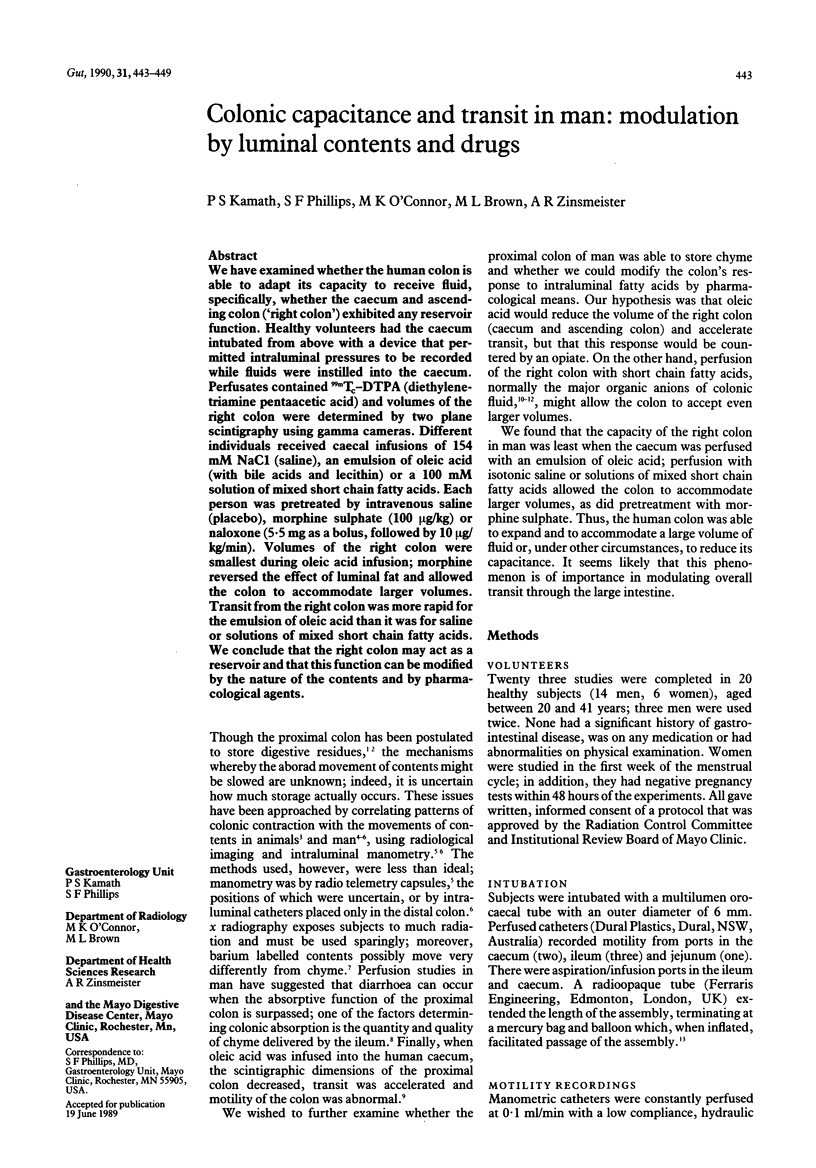
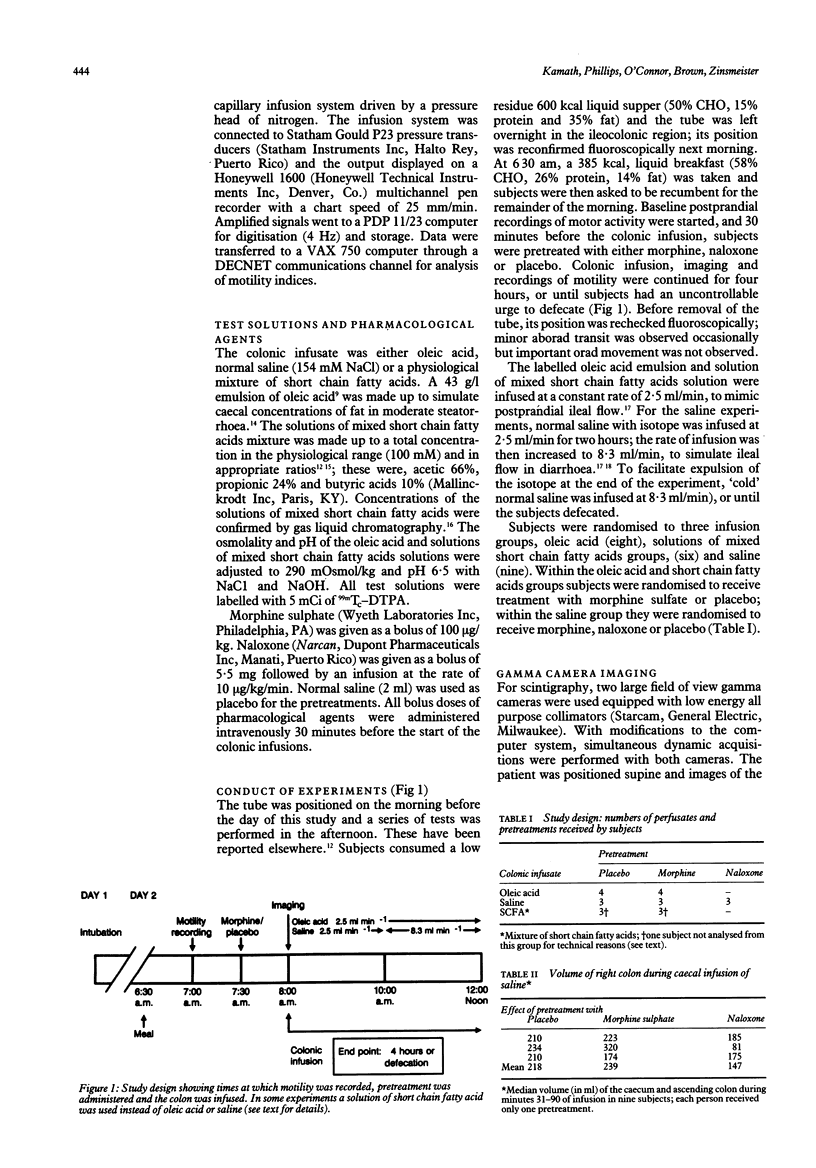
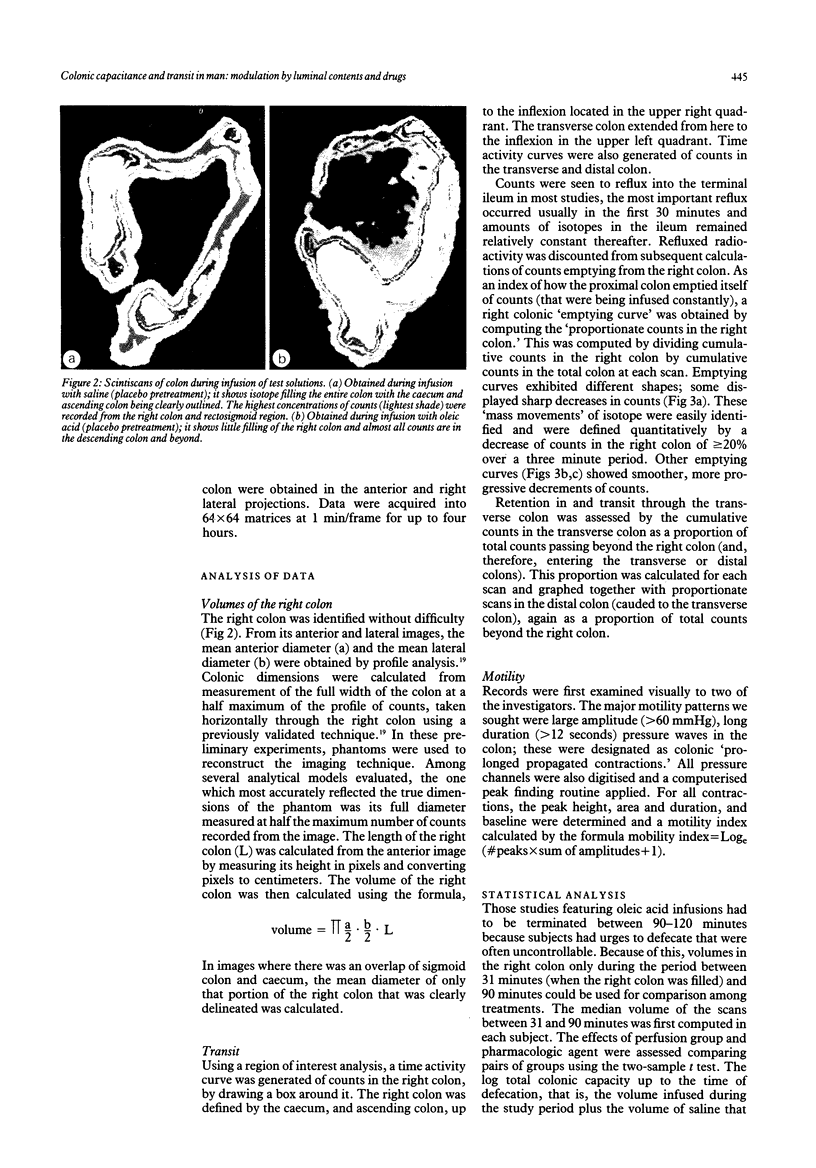
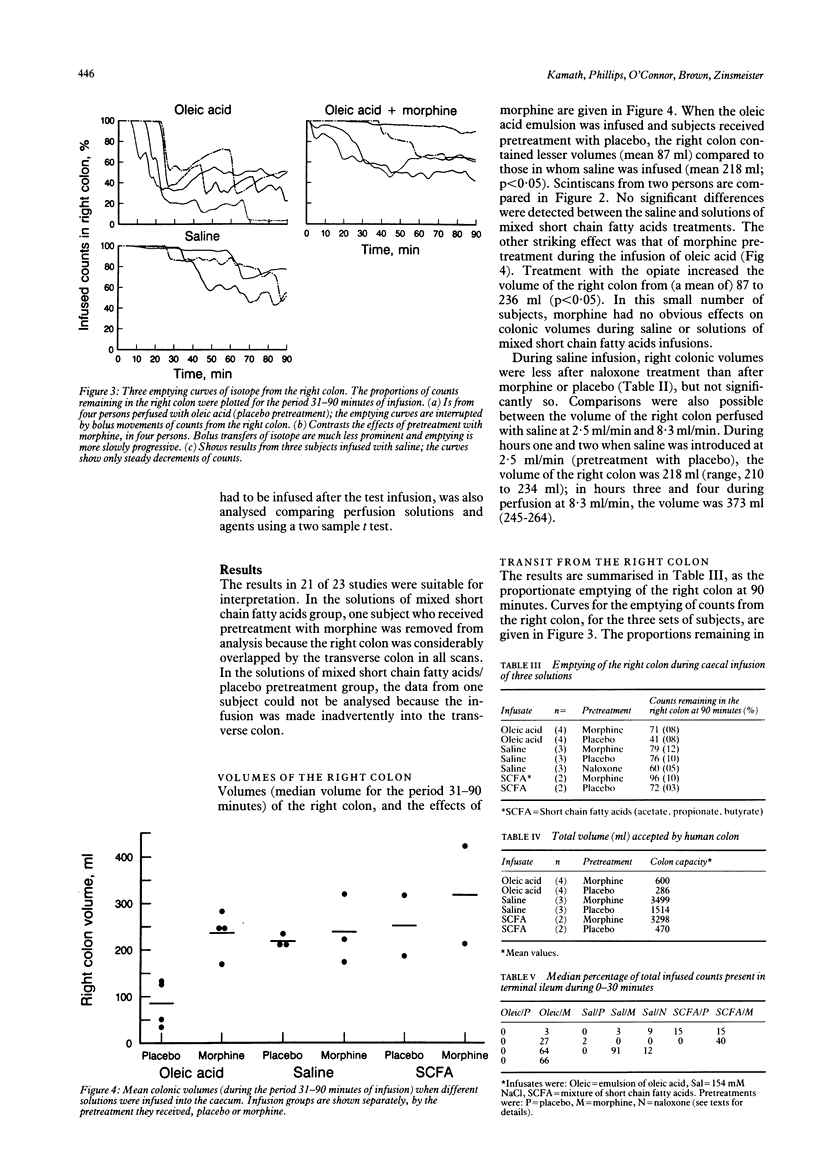
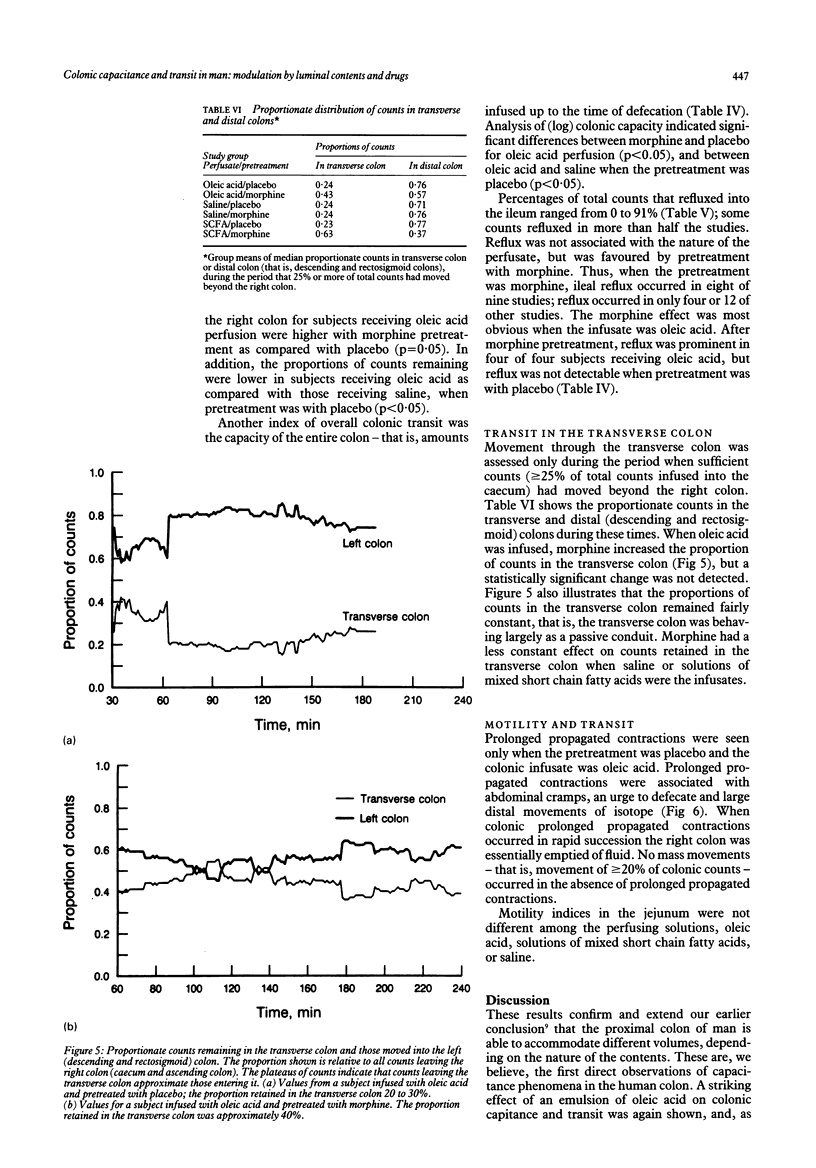
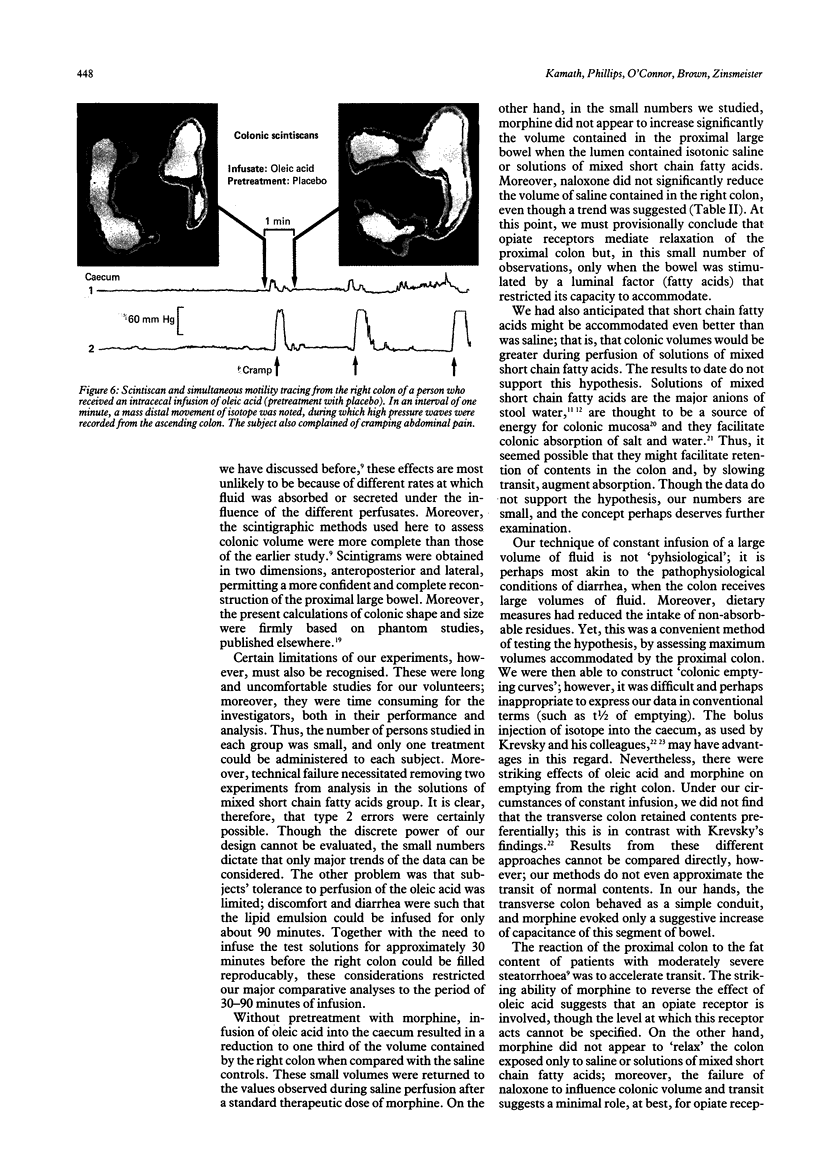
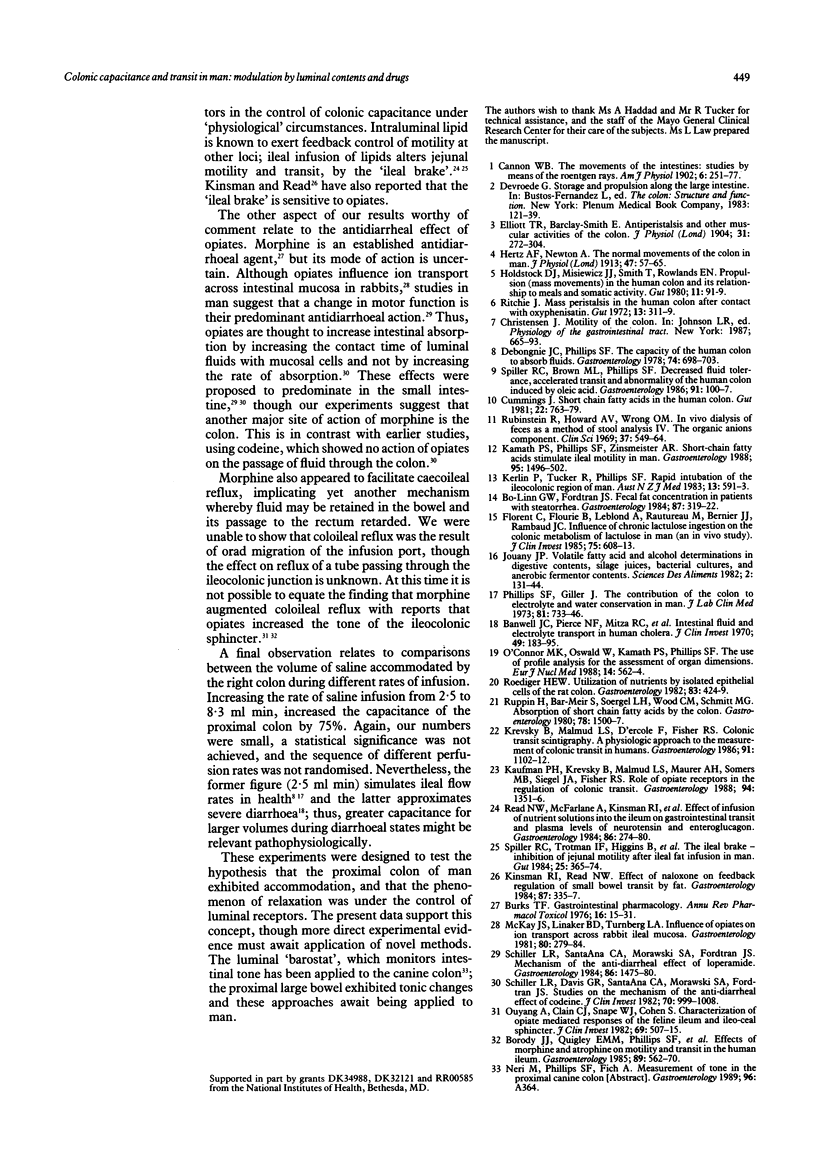
Images in this article
Selected References
These references are in PubMed. This may not be the complete list of references from this article.
- Banwell J. G., Pierce N. F., Mitra R. C., Brigham K. L., Caranasos G. J., Keimowitz R. I., Fedson D. S., Thomas J., Gorbach S. L., Sack R. B. Intestinal fluid and electrolyte transport in human cholera. J Clin Invest. 1970 Jan;49(1):183–195. doi: 10.1172/JCI106217. [DOI] [PMC free article] [PubMed] [Google Scholar]
- Bo-Linn G. W., Fordtran J. S. Fecal fat concentration in patients with steatorrhea. Gastroenterology. 1984 Aug;87(2):319–322. [PubMed] [Google Scholar]
- Borody T. J., Quigley E. M., Phillips S. F., Wienbeck M., Tucker R. L., Haddad A., Zinsmeister A. R. Effects of morphine and atropine on motility and transit in the human ileum. Gastroenterology. 1985 Sep;89(3):562–570. doi: 10.1016/0016-5085(85)90452-4. [DOI] [PubMed] [Google Scholar]
- Burks T. F. Gastrointestinal pharmacology. Annu Rev Pharmacol Toxicol. 1976;16:15–31. doi: 10.1146/annurev.pa.16.040176.000311. [DOI] [PubMed] [Google Scholar]
- Cummings J. H. Short chain fatty acids in the human colon. Gut. 1981 Sep;22(9):763–779. doi: 10.1136/gut.22.9.763. [DOI] [PMC free article] [PubMed] [Google Scholar]
- Debongnie J. C., Phillips S. F. Capacity of the human colon to absorb fluid. Gastroenterology. 1978 Apr;74(4):698–703. [PubMed] [Google Scholar]
- Elliott T. R. Antiperistalsis and other muscular activities of the colon. J Physiol. 1904 Jun 30;31(3-4):272–304. doi: 10.1113/jphysiol.1904.sp001037. [DOI] [PMC free article] [PubMed] [Google Scholar]
- Florent C., Flourie B., Leblond A., Rautureau M., Bernier J. J., Rambaud J. C. Influence of chronic lactulose ingestion on the colonic metabolism of lactulose in man (an in vivo study). J Clin Invest. 1985 Feb;75(2):608–613. doi: 10.1172/JCI111738. [DOI] [PMC free article] [PubMed] [Google Scholar]
- Hertz A. F., Newton A. The normal movements of the colon in man. J Physiol. 1913 Oct 17;47(1-2):57–65. doi: 10.1113/jphysiol.1913.sp001613. [DOI] [PMC free article] [PubMed] [Google Scholar]
- Holdstock D. J., Misiewicz J. J., Smith T., Rowlands E. N. Propulsion (mass movements) in the human colon and its relationship to meals and somatic activity. Gut. 1970 Feb;11(2):91–99. doi: 10.1136/gut.11.2.91. [DOI] [PMC free article] [PubMed] [Google Scholar]
- Kamath P. S., Phillips S. F., Zinsmeister A. R. Short-chain fatty acids stimulate ileal motility in humans. Gastroenterology. 1988 Dec;95(6):1496–1502. doi: 10.1016/s0016-5085(88)80068-4. [DOI] [PubMed] [Google Scholar]
- Kaufman P. N., Krevsky B., Malmud L. S., Maurer A. H., Somers M. B., Siegel J. A., Fisher R. S. Role of opiate receptors in the regulation of colonic transit. Gastroenterology. 1988 Jun;94(6):1351–1356. doi: 10.1016/0016-5085(88)90673-7. [DOI] [PubMed] [Google Scholar]
- Kerlin P., Tucker R., Phillips S. F. Rapid intubation of the ileo-colonic region of man. Aust N Z J Med. 1983 Dec;13(6):591–593. doi: 10.1111/j.1445-5994.1983.tb02610.x. [DOI] [PubMed] [Google Scholar]
- Kinsman R. I., Read N. W. Effect of naloxone on feedback regulation of small bowel transit by fat. Gastroenterology. 1984 Aug;87(2):335–337. [PubMed] [Google Scholar]
- Krevsky B., Malmud L. S., D'Ercole F., Maurer A. H., Fisher R. S. Colonic transit scintigraphy. A physiologic approach to the quantitative measurement of colonic transit in humans. Gastroenterology. 1986 Nov;91(5):1102–1112. [PubMed] [Google Scholar]
- McKay J. S., Linaker B. D., Turnberg L. A. Influence of opiates on ion transport across rabbit ileal mucosa. Gastroenterology. 1981 Feb;80(2):279–284. [PubMed] [Google Scholar]
- O'Connor M. K., Oswald W. M., Brown M. L., Kamath P. S., Phillips S. F. Use of profile analysis for the measurement of organ dimensions. Eur J Nucl Med. 1988;14(11):562–564. doi: 10.1007/BF00286777. [DOI] [PubMed] [Google Scholar]
- Ouyang A., Clain C. J., Snape W. J., Jr, Cohen S. Characterization of opiate-mediated responses of the feline ileum and ileocecal sphincter. J Clin Invest. 1982 Mar;69(3):507–515. doi: 10.1172/JCI110476. [DOI] [PMC free article] [PubMed] [Google Scholar]
- Phillips S. F., Giller J. The contribution of the colon to electrolyte and water conservation in man. J Lab Clin Med. 1973 May;81(5):733–746. [PubMed] [Google Scholar]
- Read N. W., McFarlane A., Kinsman R. I., Bates T. E., Blackhall N. W., Farrar G. B., Hall J. C., Moss G., Morris A. P., O'Neill B. Effect of infusion of nutrient solutions into the ileum on gastrointestinal transit and plasma levels of neurotensin and enteroglucagon. Gastroenterology. 1984 Feb;86(2):274–280. [PubMed] [Google Scholar]
- Roediger W. E. Utilization of nutrients by isolated epithelial cells of the rat colon. Gastroenterology. 1982 Aug;83(2):424–429. [PubMed] [Google Scholar]
- Rubinstein R., Howard A. V., Wrong O. M. In vivo dialysis of faeces as a method of stool analysis. IV. The organic anion component. Clin Sci. 1969 Oct;37(2):549–564. [PubMed] [Google Scholar]
- Ruppin H., Bar-Meir S., Soergel K. H., Wood C. M., Schmitt M. G., Jr Absorption of short-chain fatty acids by the colon. Gastroenterology. 1980 Jun;78(6):1500–1507. [PubMed] [Google Scholar]
- Schiller L. R., Davis G. R., Santa Ana C. A., Morawski S. G., Fordtran J. S. Studies of the mechanism of the antidiarrheal effect of codeine. J Clin Invest. 1982 Nov;70(5):999–1008. doi: 10.1172/JCI110711. [DOI] [PMC free article] [PubMed] [Google Scholar]
- Schiller L. R., Santa Ana C. A., Morawski S. G., Fordtran J. S. Mechanism of the antidiarrheal effect of loperamide. Gastroenterology. 1984 Jun;86(6):1475–1480. [PubMed] [Google Scholar]
- Spiller R. C., Brown M. L., Phillips S. F. Decreased fluid tolerance, accelerated transit, and abnormal motility of the human colon induced by oleic acid. Gastroenterology. 1986 Jul;91(1):100–107. doi: 10.1016/0016-5085(86)90445-2. [DOI] [PubMed] [Google Scholar]
- Spiller R. C., Trotman I. F., Higgins B. E., Ghatei M. A., Grimble G. K., Lee Y. C., Bloom S. R., Misiewicz J. J., Silk D. B. The ileal brake--inhibition of jejunal motility after ileal fat perfusion in man. Gut. 1984 Apr;25(4):365–374. doi: 10.1136/gut.25.4.365. [DOI] [PMC free article] [PubMed] [Google Scholar]




